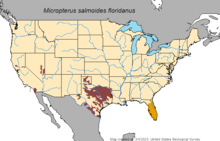Bass is a generic common name shared by many species of ray-finned fish from the large clade Percomorpha, mainly belonging to the orders Perciformes and Moroniformes, encompassing both freshwater and marine species. The word bass comes from Middle English bars, meaning "perch", despite that none of the commonly referred bass species belong to the perch family Percidae.
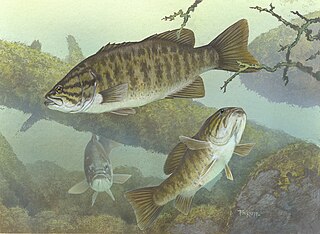
Micropterus is a genus of North American freshwater fish collectively known as the black bass, which belong to the sunfish family Centrarchidae of order Centrarchiformes. They are sometimes erroneously called "black trout", but the name trout more correctly refers to certain potamodromous members of the family Salmonidae.
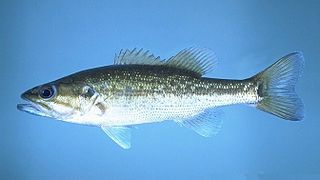
The spotted bass, also called spotty, or spots in various fishing communities, is a species of North American freshwater fish belonging to the sunfish family (Centrarchidae) of the order Centrarchiformes. It is noted for the rows of dark spots below the lateral line, which give it its common name. One of the black basses, it is native to the Mississippi River basin and across the Gulf states, from central Texas through the Florida panhandle. Its native range extends into the western Mid-Atlantic states and it has been introduced into western North Carolina and Virginia. It has also been introduced to southern Africa, where it has become established in some isolated waters as an invasive species.

The largemouth bass is a carnivorous, freshwater, ray-finned fish in the Centrarchidae (sunfish) family, native to the eastern and central United States, southeastern Canada and northern Mexico. It is known by a variety of regional names, such as the widemouth bass, bigmouth bass, black bass, largie, Potter's fish, Florida bass or Florida largemouth, green bass, bucketmouth bass, green trout, growler, Gilsdorf bass, Oswego bass, LMB, and southern largemouth and northern largemouth.

The redeye bass, redeye, or Coosa bass is a species of freshwater fish in the sunfish family (Centrarchidae) native to the Coosa River system of Georgia, Alabama. The waters it is normally found in are cool streams and rivers in the foothills of mountains.
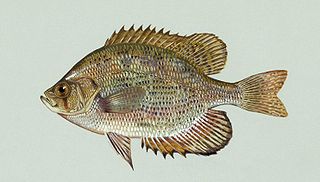
Centrarchidae, better known as sunfishes, is a family of freshwater ray-finned fish belonging to the order Centrarchiformes, native only to North America. There are eight universally included genera within the centrarchid family: Lepomis, Micropterus, Pomoxis (crappies), Enneacanthus, Centrarchus, Archoplites, Ambloplites, and Acantharchus. A genetic study in 2012 suggests that the highly distinct pygmy sunfishes of the genus Elassoma are also centrarchids.

Kamaboko (蒲鉾:かまぼこ) is a type of cured surimi, a processed seafood product common in Japanese cuisine.

The sailfin molly is a livebearer fish typically found in both freshwater and brackish waterways along the East Coast of the United States, from North Carolina south to Florida, and around the Gulf of Mexico to Texas, and south to the Yucatán Peninsula of Mexico. Given their preference for more brackish water conditions, mollies are often found within just a few yards or miles of the ocean, inhabiting coastal estuaries, lagoons, river deltas and swamps, as well as tidal areas with a regular inflow of oceanic minerals and nutrients mixing with inland freshwater sources.

Chikuwa (竹輪) is a Japanese fishcake product made from fish surimi. After being mixed well, they are wrapped around a bamboo or metal stick and steamed or broiled. The word chikuwa comes from the shape when it is sliced.

The warmouth is a freshwater fish of the sunfish family (Centrarchidae) that is found throughout the eastern United States. Other local names include molly, redeye, goggle-eye, red-eyed bream, and strawberry perch.

The Suwannee bass is a species of freshwater fish in the sunfish family (Centrarchidae) of order Centrarchiformes. One of the black basses, This species is native to just two river systems in Florida and Georgia, although it has been introduced elsewhere.

The shoal bass is a species of freshwater fish in the sunfish family (Centrarchidae) of order Centrarchiformes. One of the black basses, it is native to waters in Florida and Georgia. It is also occasionally found in rivers and streams of East Alabama where it has been declared an endangered species and cannot legally be kept if caught by fishermen. Of typical size for a black bass, M. cataractae reaches a maximum recorded length of 24 inches (61 cm) and a maximum published weight of 8 pounds, 12 ounces.

The brook stickleback is a small freshwater fish that is distributed across the US and Canada. It grows to a length of about 2 inches. It occupies the northern part of the eastern United States, as well as the southern half of Canada. Small populations are scattered throughout the Mississippi-Great Lakes basin extending to Colorado, New Mexico, Kentucky, Tennessee, etc., though some of these areas are not native to the species. This small fish inhabits clear, cool streams and lakes. They eat small Invertebrates, algae, insect larvae, and occasionally their own eggs. They are also preyed upon by smallmouth bass and northern pike. Feeding time is usually dawn and sunset. The brook stickleback does have active competition mostly from minnows, but feeding times are different, along with diet. Spawning occurs in midsummer. Males secure a territory, build a nest, and mate with females. Males provide protection for the eggs, ward off predators, and usually die later in the season. The nests are built out of aquatic grasses. This is considered an annual species. Though the brook stickleback is not considered a threatened species, deforesting and changing waters are altering ecosystems of the species. Harvesting of trees around riparian environments is having a large effect of the stream ecosystem where the brook stickleback resides.
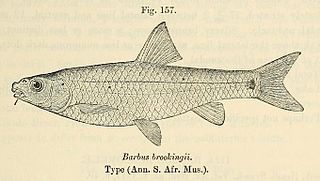
The border barb is a ray-finned fish species in the family Cyprinidae. It is the only species in the genus Amatolacypris. Like Pseudobarbus, it is tetraploid.
Boskop Dam is an earth-fill type dam on the Mooi River, near Potchefstroom, North West Province, South Africa. It was constructed in 1959. The main purpose of the dam is for irrigation and domestic usage. Its hazard potential is ranked as high, due to poor maintenance and the development of sink holes.
M. nigricans may refer to:

The swamp darter is a species of freshwater ray-finned fish, a darter from the subfamily Etheostomatinae, part of the family Percidae, which also contains the perches, ruffes and pikeperches. It is endemic to the Eastern United States.
David P. Philipp is an American-born biologist known for his work on conservation genetics, reproductive ecology, and the effects of angling on fish populations. He is a conservation geneticist and Director of the Fisheries Genetics Lab at the Illinois Natural History Survey, an adjunct professor at the University of Illinois, and the Chair of the Fisheries Conservation Foundation. Philipp has supervised a number of graduate students including Steven J. Cooke, Cory Suski, Derek Aday, Jeff Koppelman, Jana Svec, Jimmy Ludden, Dale Burkett, Sascha Danylchuk and Jeff Stein.

Blepsias cirrhosus, the silverspotted sculpin, is a species of sculpin belonging to the subfamily Hemitripterinae of the family Agonidae. This species is found the northern Pacific Ocean from the Sea of Japan and Alaska to San Miguel Island off southern California.

Micropterus henshalli, the Alabama bass, is a medium-sized freshwater ray finned fish, a black bass from the genus Micropterus which is part of the sunfish family Centrarchidae. This species is endemic to the southeastern United States where it is native to the rivers which drain into Mobile Bay in Florida, Alabama, Mississippi and Georgia where they are found in pools in rivers which have a good flow and in impoundments. They have been introduced elsewhere in the United States and the hybridisation of this species with the redeye bass after Alabama bass were introduced into Keowee Reservoir, South Carolina is thought to have probably been the cause in the decline in the population of redeye bass. Micropterus henshalli was first formally described as a subspecies of the spotted bass by Carl Leavitt Hubbs and Reeve Maclaren Bailey in 1940 with the type locality given as Jefferson County, Alabama. The specific name honors James A. Henshall who was a bass angler.

